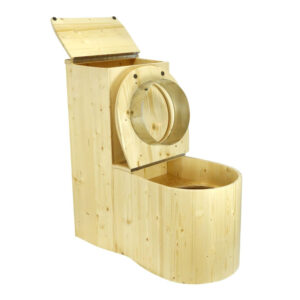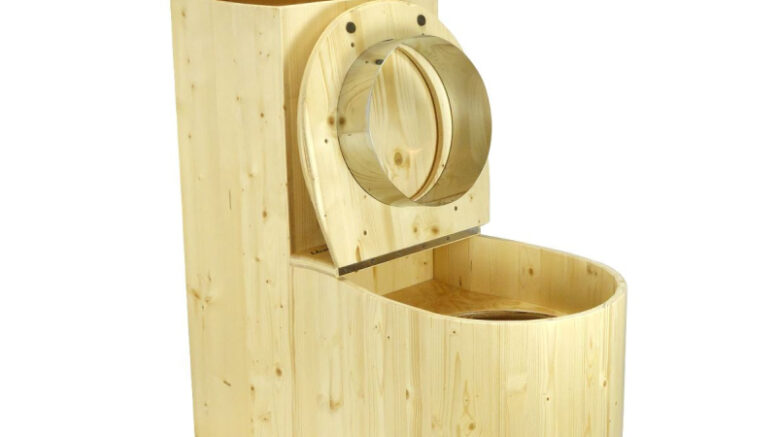 Well it is done, the old water closet has been removed and now we are learning to live with a dry toilet.
Well it is done, the old water closet has been removed and now we are learning to live with a dry toilet.
There were a number of reasons to remove the old water closet. Two exceptionally dry years have had us constantly worried about the spring, every available drop of water is needed for the plants, the shower and the sink. We already re use all the washing grey water, both dishes and clothes by using only organic soaps to wash with, indeed the only grey water to go down the pipes is shaving and shower water. Secondly the toilet was getting old and unreliable, it did not flush properly and started to smell, and thirdly the septic tank was filling up and I did not want to pay to have a professional company to come and empty it. Lastly I always had a problem with literally throwing away the shit, with the land around us so poor in humus, indeed in any vegetable matter at all, it always seemed nonsensical to not recycle human waste. We compost vegetable waste, so why not do the same with human waste?
Two hard year of drought have brought chaos to the South of France, vines, still the dominant sector in the Corbieres agricultural production have been hit hard with friends talking about up to an 80% drop in harvest. Eighty is at the extreme end, but 50% is roughly around the average and marks an existential threat to the viability of the sector. Vines are the highest profile casualties but cereal and fodder production, market gardening, and available grazing has also been adversely effected. Hose pipe bans have been frequent throughout the Aude and the Pyrenees Oriental for the last two years, which has also hot our plant sales, why buy a plants only to watch them die through enforced neglect?
Being reliant on a single water source has certainly focussed Caroline and I on our vulnerability to water stress. If the source dries up we have no alternative apart from collecting water from outside the Domaine and transporting it to use. Our neighbours at Pique Rouge at the other extreme of the Collume of Maisons have had to do this for the last two years and it is no fun, as well as being expensive and time consuming.
A quick look at the loo is quite revealing, every flush even on a new loo uses around 6 litres of water, and our loo could not be described as cutting edge. An average of six flushes a day per adult quickly rakes up, On average, a person uses 210 litres of water weekly or 840 litres monthly for their flushing needs. Even using the old hippy adage of “If it is brown wash it down if it is yellow let it mellow” It still adds up.
The practicalities. Firstly there is the dry toilet itself. A quick look online shows the ingenuity of the human imagination in designing what is essentially a box with a bucket in it. Given my limited carpentry skills I went for a basic box with an opening lid to lift the bucket out of. Large enough to have storage space for extra loo rolls, and to feel secure, I did not want to feel like the whole thing could tip over. I also did not want to attach it to the wall, if, Lord Forbid, I ever have an accident lifting the bucket out I want to be able to shift the loo to clean up.
I found the ideal bucket, and a stainless steel rim locally, from LecoPot over in Couiza. The wood and toilet seat came from our local builder’s merchant.
Secondly a good spot needs to be found for the recycling, far enough away from the house to not ve affected by the odours but close enough to make the twice weekly emptying trips not to strenuous. Our old vegetable patch was ideal, plus the fact that it is fenced odd, I have no desire to feed the local wildlife, nor our pesky and inquisitive dogs.
Third ensuring a sources of the dry, and compostable, material; ideally wood chippings, to sprinkle in the bucket, both to cover the odour and absorb the urine. In ly case I have a semi pro petrol powered wood chipper and an endless supply of tree branches; and other wood type waste around the Domaine. Having a local carpenter, or wood workers could be handy as they are often looking doe a sustainable use for their shavings. You also need to find suitable containers to store the stock of whippings in and one to have handy by the loo. I found an old bin, from of all place Dorset County Council at our dump; and an ash bin for the bathroom.
Now we have had our new dry toilet since early Autumn, so still not a Summer yet. Here is what we have leant so far. The smell; if emptied regularly, is not in anyway intrusive. If anything it is less than our old cranky loo. Regular emptying is best, lighter to carry down to the compost bin. We have a small peddle bin next to the loo for used toilet paper as we found when warm that the loo paper absorbs the urine and smells a bit if dropped into the bucket. The peddle bin gets emptied into the bucket before being carted off toe the compost.
Yes a dry toilet involves more work that a WC, emptying, cleaning, chipping, but it is far from onerous. The biggest job is the chipping. For us the chipping is a regular part of our constant management of the trees near our house so our usual work load is not drastically changed.
A note on the compost. Unlike vegetable waste wood chippings take time to break down, I think we are looking at a three year process. Now maybe because I have started with fresh pine it is even slower, pine chippings seem to have an anti fugal component that slows down the formation of mushrooms but already I can see a second compost bin may be needed, possibly a third one as well I have a 1,000 litres pre-fabricated plastic compost bin, because of the nature of the compost I thought building a wooden one out of old pallets would see them rot at the same speed as their contents. I will just wait for an offer from the local shops and buy when dirt cheap.
Our conclusion on living with a dry toilet so far is very positive, let us see whether it stays that way in full Summer.

